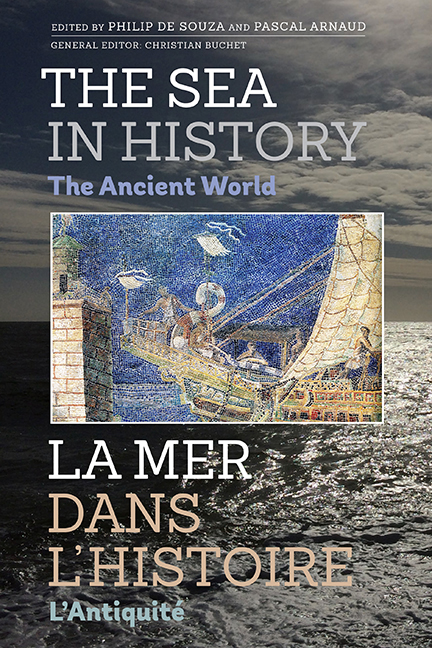Book contents
- Frontmatter
- Contents
- List of Illustrations
- List of Contributors
- Introduction générale et remerciements par Christian Buchet
- General introduction and acknowledgements
- Introduction (français)
- Introduction (English)
- La mer est le propre d'Homo sapiens
- PREHISTORICAL CASE STUDIES
- Maritime aspects of early Andean civilizations
- Une approche maritime et archipélique de l'occupation amérindienne des Antilles
- The Taíno of the Caribbean: six thousand years of seafaring and cultural development
- The importance of the sea for prehistoric societies in Western Europe
- Pêche et interactions entre la Moyenne Vallée du fleuve Sénégal et le littoral atlantique Sénégalo-Mauritanien durant le dernier millénaire BC
- The sea and early societies in the Japanese Islands
- Développement maritime de la civilisation océanienne
- HISTORIAL CASE STUDIES: The Ancient Near East and Pharaonic Egypt
- HISTORICAL CASE STUDIES: The Mediterranean world
- HISTORICAL CASE STUDIES: The Indian Ocean and the Far East
- Conclusion (français)
- Conclusion (English)
- Conclusion générale par Christian Buchet
- General conclusion
- Comprendre le rôle de la mer dans L'histoire pour éclairer notre avenir
- Understanding the role the sea has played in our past in order to shed light on our future!
Une approche maritime et archipélique de l'occupation amérindienne des Antilles
from PREHISTORICAL CASE STUDIES
Published online by Cambridge University Press: 20 April 2017
- Frontmatter
- Contents
- List of Illustrations
- List of Contributors
- Introduction générale et remerciements par Christian Buchet
- General introduction and acknowledgements
- Introduction (français)
- Introduction (English)
- La mer est le propre d'Homo sapiens
- PREHISTORICAL CASE STUDIES
- Maritime aspects of early Andean civilizations
- Une approche maritime et archipélique de l'occupation amérindienne des Antilles
- The Taíno of the Caribbean: six thousand years of seafaring and cultural development
- The importance of the sea for prehistoric societies in Western Europe
- Pêche et interactions entre la Moyenne Vallée du fleuve Sénégal et le littoral atlantique Sénégalo-Mauritanien durant le dernier millénaire BC
- The sea and early societies in the Japanese Islands
- Développement maritime de la civilisation océanienne
- HISTORIAL CASE STUDIES: The Ancient Near East and Pharaonic Egypt
- HISTORICAL CASE STUDIES: The Mediterranean world
- HISTORICAL CASE STUDIES: The Indian Ocean and the Far East
- Conclusion (français)
- Conclusion (English)
- Conclusion générale par Christian Buchet
- General conclusion
- Comprendre le rôle de la mer dans L'histoire pour éclairer notre avenir
- Understanding the role the sea has played in our past in order to shed light on our future!
Summary
RÉSUMÉ.En s'appuyant sur différentes preuves archéologiques et sur les écrits des premiers explorateurs européens, cette contribution démontre comment l'implantation humaine dans les îles de l'archipel des Antilles fut facilitée par la situation même de la région caribéenne, décrite par les savants comme « un continent séparé par les eaux » et encourageant par là l'échange et le commerce d'une île à l'autre, mais également par la richesse des ressources naturelles de la mer des Caraïbes.
ABSTRACT.This contribution demonstrates, from archaeological evidence and the writings of early European explorers, how human settlement of the islands of the Antilles archipelago was facilitated by the Caribbean region being what scholars have described as “a continent divided by water”, encouraging inter-island communication and trade, and by the rich natural resources provided by the Caribbean Sea.
Where are your monuments, your battles, martyrs?
Where is your tribal memory? Sirs,
in that grey vault. The sea. The sea
has locked them up. The sea is History…
Derek WalcottSamedi 13 octobre 1492, île de Guanahani (actuelle San Salvador, Bahamas).
« Ils vinrent à la nef sur leur almadias qui sont faites comme de longues barques,
d'un tronc d'arbre tout d'une seule pièce, travaillées à merveille pour ce pays, et si
grandes que dans quelques-unes allaient quarante ou quarante-cinq hommes. »
Dimanche 21 avril 1619, île d'Iouanacaera (actuelle Martinique).
« Le dimanche 21 avril, arrivâmes à l'une des îles nommée Martinicque où,
passant à l'endroit d'une habitation d'un capitaine nommé Salomon, l'un des
principaux de l'île, nous vint reconnaître de fort loin dans une pirogue où y avait
dix ou douze sauvages tout nus et peints de rouge… »
- Type
- Chapter
- Information
- The Sea in History - The Ancient World , pp. 55 - 65Publisher: Boydell & BrewerPrint publication year: 2017

